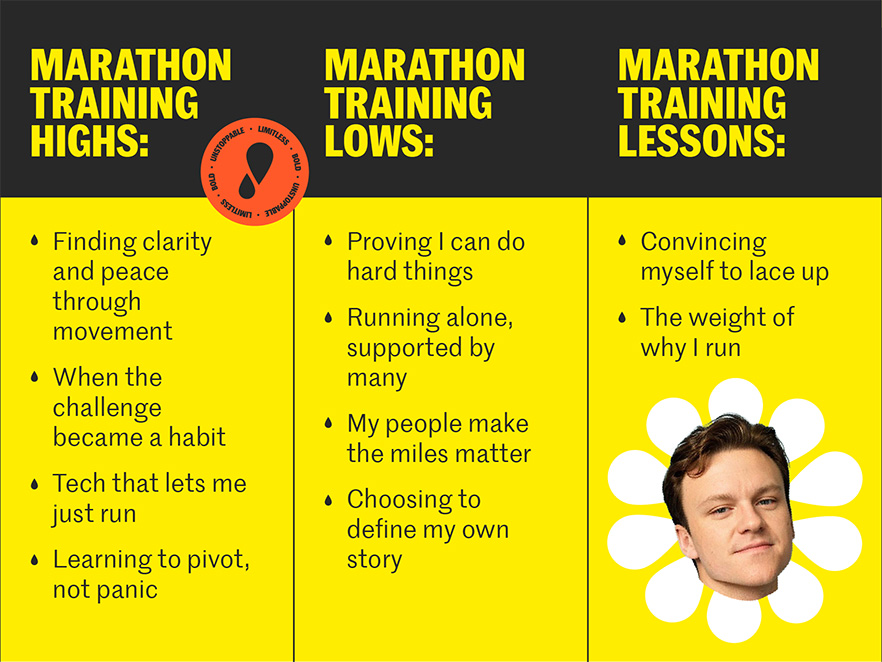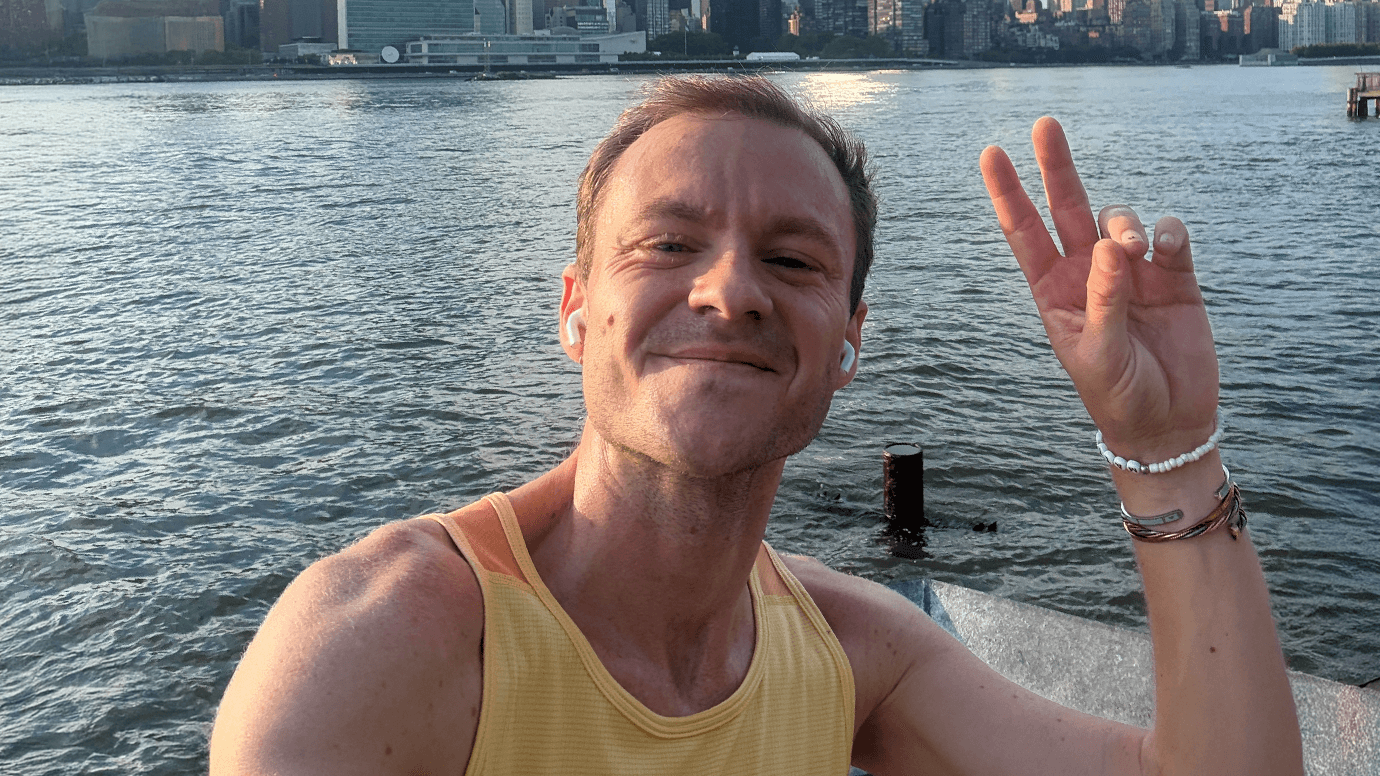For Tanner Saunders, running isn’t just about crossing a finish line—it’s about living boldly and unapologetically with type 1 diabetes. Diagnosed at age 7 and now 32, he’s lacing up for the NYC Marathon with the Beyond Type Run team, turning 26.2 miles into a celebration of 25 years of resilience.
After facing burnout, running became Saunders’ reset button. But when his husband passed away from diabetes this summer, that loss became both fuel to keep going and a powerful reminder of life’s fragility.
With the support of his community and a whole lot of grit, Saunders is proving that big goals don’t need perfect conditions—they’re built in the messy, real moments along the way. Sore knees and off days don’t stop the journey; they make it human.
Here’s a look at Saunder’s training highs, lows and everything in between.
*Responses have been edited for brevity and clarity

Marathon Training Highs
Finding clarity and peace through movement
I’ve found that the best part of marathon training is how running has become a mental safe place for me. It’s less about the miles and more about clearing my head—working through everything that weighs on me.
This year’s been the hardest of my life after losing my husband, Matthew, in June, and running has given me space to process that. Sometimes it’s just about moving, letting my brain catch up to everything. And along the way, it’s helped me discover new corners of the city—like this beautiful park in Long Island City I never would’ve found otherwise.
When the challenge became a habit
The first time I realized I could just put on my shoes and run 12 miles without overthinking it, I was like, ‘whoa, that just happened.’ Back in January, one mile felt impossible, and now it’s second nature. My tech has made it easier to manage my glucose, so I can just focus on running. More than anything, marathon training has given me a habit I’m proud of—something I know will last well beyond race day.
Tech that lets me just run
I use the Dexcom G7 [continuous glucose monitor (CGM)] and absolutely love it—it’s small, easy to put on, and super convenient. I also wear an Omnipod [insulin pump], and the best part is how seamlessly they work together. With my Dexcom G7, I can see my numbers right on my phone or Apple Watch while I’m running. Everything I need is right there if something comes up—but honestly, most of the time, I don’t even have to think about it. That’s the best part.
Learning to pivot, not panic
Marathon training has really pushed me outside my diabetes comfort zone. You can plan all you want with snacks and gels, but sometimes things don’t go as expected—and that’s okay. It’s taught me to trust my decisions and stay calm when highs or lows happen mid-run. I had a bad low on a long run recently and had to stop early, which was tough. But it reminded me that strength isn’t just finishing the miles—it’s knowing how to adapt and take care of myself along the way.
Marathon Training Lows
Convincing myself to lace up
One of the biggest lows of marathon training is simply the commitment. I try to stick to my schedule, but some days I wake up and just don’t want to run. Early on it’s easy, but as the mileage creeps up, the time and energy it takes gets real. The hardest part is often just getting myself out the door—but I’m always happier after a run than when I skip one. That push through the resistance is part of what makes it worth it.
The weight of why I run
For me, the marathon is a huge mental hurdle because my life looks so different now. Matt passed away just weeks after I found out I’d be running, so every mile since has carried his memory with it. Losing him to diabetes was a brutal reminder of how fragile life can be — even when you do everything “right.” It changed how I see my own diagnosis and what this race means. What started as a way to prove diabetes couldn’t stop me has turned into a way to honor him and pour my energy into something that matters.
Marathon Training Lessons
Proving I can do hard things
One of the biggest lessons for me has been proving to myself that I can actually do this. Running a marathon always felt like one of those big, “someday” goals, and now I’m doing it. I’ve learned so much from other people living with diabetes who’ve done this before me, applying what I know about diabetes in a totally new way. It’s also shown me that I genuinely love running and taking care of myself, even on the days when getting out the door feels impossible. But once my shoes are tied, I know I’ll be glad I did.
Running alone, supported by many
Community means everything to me. I’m lucky to have an incredible support system in New York and beyond. Running might feel like a solo sport, but my people make sure I never feel alone in it. They check in, hype me up, and keep me accountable—especially on the days I don’t want to lace up. Honestly, their push is a big part of what keeps me going.
My people make the miles matter
Friends and family are flying in from all over, and my colleagues are showing up too—which adds a little pressure, but the good kind. No one cares about my time; they just want to see me cross that finish line. On top of that, being surrounded by other people with diabetes has been grounding. Even if I stopped running tomorrow, I’d still have this incredible network that just gets it.
Choosing to define my own story
My biggest takeaway is simple: tomorrow isn’t promised. I’m grateful this journey reminded me to put myself first and care for more than just the numbers. Diabetes doesn’t define me—it’s just one part of my story. Whether I’m a marathon runner, a travel journalist, or just Tanner from Texas, I get to choose how I show up. And this year, I chose to run.
Tanner’s not running this race alone. He’s repping the Beyond Type Run squad, proving T1D doesn’t set the pace. Want to back his journey? Check out his fundraising page!
This content was made possible by Dexcom, an active partner of Beyond Type 1. Beyond Type 1 maintains editorial control over its content.

